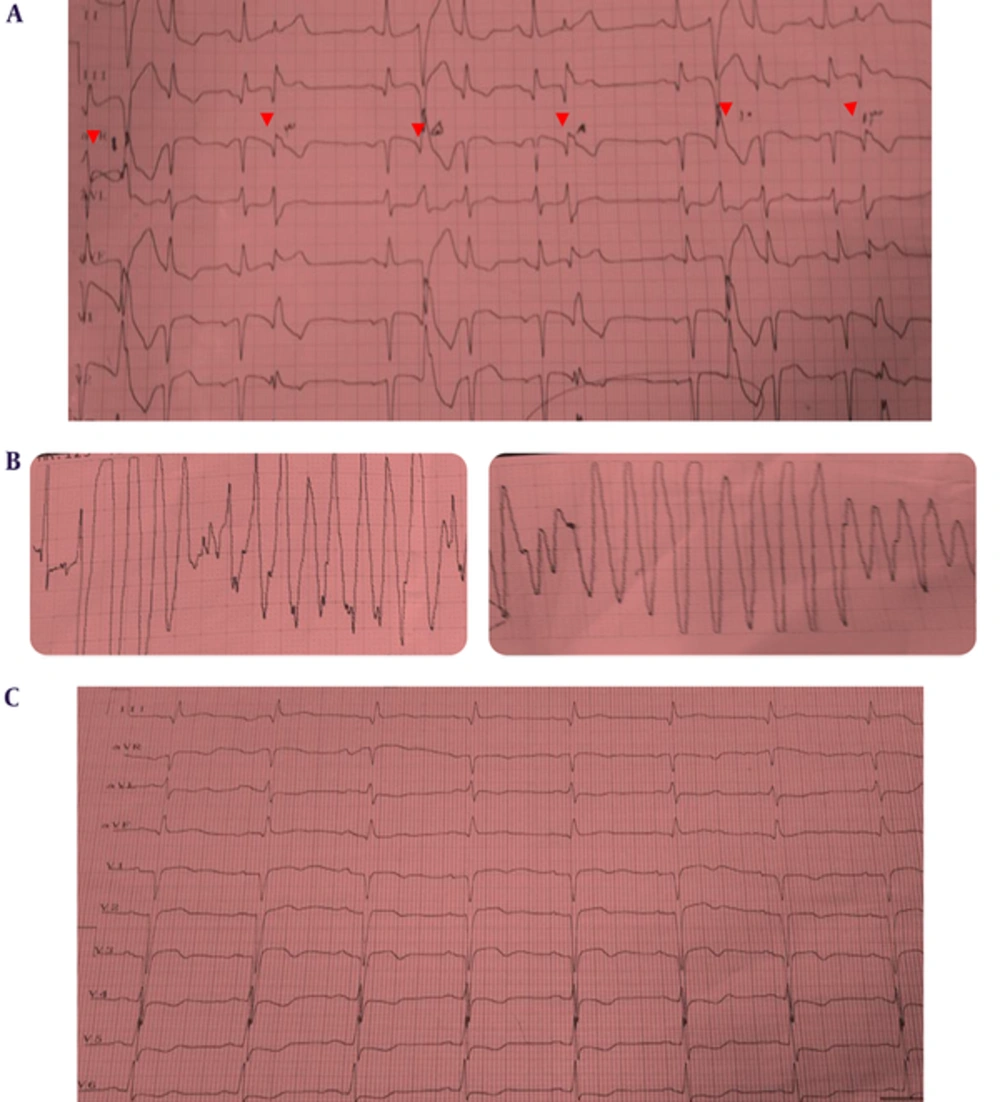1. Introduction
Torsade de pointes (TdP) is a potentially lethal arrhythmia, which majorly occurs in the context of QT interval prolongation (QTc > 500 msec). Gene mutations, administration of certain pharmaceutical agents, and electrolyte disorders result in long QT syndrome and TdP. Anesthetic procedures can also cause TdP in long QT syndrome patients due to anesthetic drugs.
TdP episodes usually produce syncope. Furthermore, sudden death in long QT syndrome results from ventricular fibrillation triggered by TdP (1-4). Ischemic conditions, such as acute myocardial ischemia, have been lately considered as other possible mechanisms or variants of QT interval prolongation and subsequently probable fatal arrhythmia (5). There are few reports on TdP in the context of IHD in the literature. The present report describes TdP episodes in an IHD patient with seizure.
2. Case Presentation
A 64-year-old man with complaints of increasing chest pain extended to the left arm was admitted to the cardiac unit of our hospital with a diagnosis of unstable angina. He had a history of exertional chest pain in the past month, which had lately turned to rested chest pain without any special activity. He had a history of diabetes mellitus. He was treated for acute coronary syndrome and his symptoms alleviated.
After 24 hours of admission, the patient experienced myoclonic jerks (sudden, involuntary movements of the muscles) for 1 minute, as well as transient changes in consciousness. He received neurological consultation with a suspicion of transient ischemic attack. Based on the consultation, brain CT scan was performed, which indicated normal results. Few hours later, he reexperienced myoclonic jerks and transient changes in consciousness.
Considering the patient's symptoms, cardiac monitoring was performed. The patient had ventricular tachycardia (VT) and TdP episodes during monitoring, which were managed by the application of DC shocks (Figure 1A and 1B). He was transferred to a more specialized cardiac unit with normal sinus rhythm for further evaluations (Figure 1C). The patient’s laboratory test results were as follows: at admission (FBS, 193; Ca, 9.3; pH, 7.47; K, 4; CKMB, 22; TPI negative); 24 hours postadmission (pH, 7.42; K, 3.9; CKMB, 26; Na, 138; Mg, 2.2; nearly positive TPI).
Primary percutaneous coronary intervention (PCI) was performed, indicating the following results: left anterior descending artery (LAD), 95%; left circumflex artery (LCX), 95%; right coronary artery (RCA), 100%. Balloon angioplasty (POBA) was used for stenosis treatment and elimination of cardiac arrhythmias. Following that, the patient was listed for coronary artery bypass grafting (CABG) (Figure 2).
3. Discussion
We described a case of TdP in an IHD patient with the presentation of seizure. Apart from drugs and electrolyte imbalance, there are other comorbid conditions, such as uncontrolled diabetes mellitus and probably myocardial ischemia, which can lead to TdP (3, 6-8). TdP episodes produce syncope or pseudoseizure secondary to an abrupt reduction in cerebral blood flow. In a number of patients referred to emergency departments, IHD may not be accompanied by typical clinical symptoms, such as chest pain. Besides, many patients may have unrelated symptoms, which may lead to delayed diagnosis in many cases.
Ischemic conditions have been considered as possible mechanisms for the prolongation of QT interval (5). Several studies have suggested myocardial ischemia as a variant of progressive prolongation of QT interval and the corresponding action potential duration, which may cause fatal arrhythmias, such as TdP and sudden cardiac death (9-11). According to these studies, TdP episodes, which are triggered by ischemia or other conditions, may either terminate spontaneously producing some misleading symptoms, similar to the present case (with transient seizure episodes at admission), or may lead to more lethal arrhythmias.
In this regard, Nakajima et al. (2010) presented the case of a male patient with postischemia-associated TdP, who had no evidence of long QT syndrome. The patient experienced recurrent polymorphic VT and TdP, with excessive QT interval prolongation and clinical symptoms 2 days after transient myocardial ischemia (12). Since there are many major risk factors and predisposing clinical conditions triggering TdP, careful clinical and laboratory assessments are essential for each patient.
Conclusions
Transient seizure episodes may be due to cardiac arrhythmias, severe bradycardia, or transient asystole. All these conditions should be taken into consideration in the management of IHD patients with seizure.

